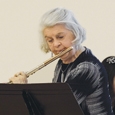
Katherine Hoover graduated from the Eastman School of Music in 1959 where she studied flute performance with Joseph Mariano. She received a bachelor’s degree in music theory and a performer’s certificate in flute. She spent two years in Philadelphia, where she worked with William Kincaid, and in 1961 joined the faculty of the Juilliard preparatory department to teach flute. In 1969 she joined the theory faculty of the Manhattan School, where she had previously earned a master’s degree in music theory.
During the 1970s, while continuing to perform actively, she began to arrange music, and then to compose. During the early 1980s she wrote Medieval Suite, Lyric Trio, a Double Concerto for two violins and strings, a piano Quintet Da Pacem, and orchestral works. During these years she continued to perform, playing for summer ballet performances at the Metropolitan Opera House and as principal flute for New York Grand Opera. For ten years she soloed with the New York Concerto Orchestra at Damrosch Park in Lincoln Center, performing all three Mozart Concerti, the Bach Suite in B Minor, Telemann Suite in A Minor, and the premiere of her Summer Night.
In 1990 on a trip to the Southwest, she wrote Kokopeli which has become her best known work and sold over 10,000 copies. She started her own publishing company, Papagena Press, with this piece. (Papagena Press is now distributed by Theodore Presser Company.) In 1994 she received an Academy Award from the Academy of Arts and Letters and a grant from the NEA. That same year she conducted the Harrisburg Symphony in the premiere of her tone poem Night Skies. She continues to work on commissions and projects of many kinds. She has given masterclasses at various colleges and other venues.
What is your compositional style?
I’m familiar with Western music from Gregorian Chant up to the latest, and also with some music from Greece, India and the Middle East; not to mention Native American influences. So I draw from different sources that seem to fit the piece I’m writing.
What were your influences?
William Kincaid’s stringent work with me on basic phrasing and some Dalcroze work on movement with rhythm were pivotal to my development. At Eastman, our theory classes were based on Bach, two hours a day for two years. This covered chromatic harmony and counterpoint thoroughly. While teaching theory at the Manhattan School, I analyzed numerous scores from all periods, copying and studying like early composers did.
Barbara Tuchman’s book about the 14th-century inspired my Medieval Suite, and another non-fiction work Eleni by Nicholas Gage inspired my most performed orchestral work Eleni: a Greek Tragedy. Art works have inspired me as well as in Masks or Night Skies for orchestra.
Are your works programmatic or absolute music?
Though many of my works are inspired by extra-musical sources, very few are actually programmatic, as if following some sort of script. I’m happiest when a piece finds its own form.
What are your thoughts on the essence of music?
Music is based on movement in time, as is our very physical existence. Therefore, rhythm is the basis, whether it is free flowing, as in Kokopeli, or totally structured as the Dizi Dance in my Mountain & Mesa. In general, music makes sense to us as long as at least one element – melody, harmony, or rhythm – has a shape we can hear and understand. Beyond that it’s free play in the sandbox for composers!
What should a performer know when performing your works?
It is best to learn the piece by yourself, and not listen to others. Develop your own musical ideas. Start by carefully following the dynamics, rests, and tempo indications and listening carefully to shapes of the phrases. (Keep in mind that tempi are often set at a piano or computer and can be too fast for instruments that breathe, are bowed, or otherwise sustain.) Questions can be referred to your teacher or coach, and if some aspects are still unclear, contact the composer.
Works by Katherine Hoover
Solo Flute
Kokopeli (1990) (Recorded by Katherine Hoover, Mark Sparks, Laurel Zucker, Eugenia Zukerman, Stephanie Rea, Leone Buyse, Teresa Beaman, Tadeu Coelho, Kristen Stoner)
Winter Spirits (1997) (Recorded by Wendell Dobbs, Laurel Zucker, Stephanie Rea, Katherine Hoover, Christina Jennings, Rachel Rudich, Kristen Stoner)
To Greet the Sun (2005)
Reflections: Variations on a an Ancient Norwegian Chant (1982) (Recorded by Wendell Dobbs, Eugenia Zuckerman, Stephanie Rea, Katherine Kleitz)
Etudes (2011)
Flute and Piano
Medieval Suite (1986) (Recorded by Alexa Still, Jannine Dennis, Don Bailey, C. Thorspecken, Susan Levitin)
Masks (1998) (Recorded by Marilyn Shotola, Katherine Hoover, Merrie Siegel)
Mountain & Mesa (2010) (Recorded by Mimi Stillman)
Two or More Flutes
Celebration (2001)
Sound Bytes (1990) (Recorded by Claudia Anderson, Karen Yonovitz)
Trio for Flutes (1974)
Three for Eight (1996) (Recorded by Uptown Flutes)
For Multiple Flutes
Peace is the Way
Kyrie
Clowning Around
Mariposas
Concertante “Dragon Court”
Flute and Guitar
Canyon Echos (1991) (Recorded by Bonita Boyd, Wendell Dobbs, Laurel Zucker, Susan Morris DeJong)
Caprice (1999) (Recorded by Jan Boland)
Other Chamber Music
Homage to Bartok (1975) for wind quintet
Flute Violin, Cello Divertimento (1975) (Recorded by Wendell Dobbs)
Flute, Cello, Piano Lyric Trio (1982) (Recorded by Christiane Meininger, Diane Gold)
Dances & Variations (1995) (Recorded by Wendell Dobbs, Laurel Zucker) for flute and harp.
Three Sketches (Recorded by Christina Ledford) for piccolo and piano.
Summer Night for flute, horn, and strings (Recorded by Katherine Hoover)
Two for Two (alto flute and piano, bass flute and piano) (Recorded by Laurel Swinden)





